India Introduces Unified Command Structure for Military Forces

In a significant development for India's military framework, the government has granted authorization for the Chief of Defence Staff (CDS) and the Secretary of the Department of Military Affairs (DMA) to jointly issue directives to the Indian Army, Navy, and Air Force. This move, which has been anticipated for a long time, marks the end of a longstanding tradition where each branch of the armed forces operated with its own separate instructions. It heralds a new phase of integrated and coordinated national defense.
Sanctioned by the Honourable Raksha Mantri, this reform is in line with the broader goals of the 2025 "Year of Defence Reforms" initiative. It seeks to foster unity, enhance responsiveness, and bring about strategic clarity across all branches of the armed forces. The initial joint directive issued under this unified command emphasizes simplifying procedures, eliminating redundancies, and fostering better synergy in military operations.
This reform implements recommendations that emerged following the 1999 Kargil War, which highlighted significant deficiencies in inter-service coordination. It builds upon pivotal developments, such as the establishment of the Integrated Defence Staff in 2001 and the appointment of General Bipin Rawat as India's inaugural CDS in 2019.
India's defense budget for 2025, set at an unprecedented $500 billion or 2.5% of the national GDP, illustrates the scope and ambition of the current effort towards military modernization. Experts suggest that the newly established joint command structure could boost the effectiveness of joint operations by as much as 30%, a forecast supported by a 2020 report from the Royal United Services Institute (RUSI).
This reform also incorporates insights gained from key operations like Operation Ganga in 2022, which involved the rapid evacuation of over 18,000 Indian nationals from Ukraine, demonstrating effective military and diplomatic coordination. Officials are optimistic that the new system will better equip India to handle both conventional warfare and multi-domain challenges, thereby enhancing its strategic position both domestically and internationally.



















